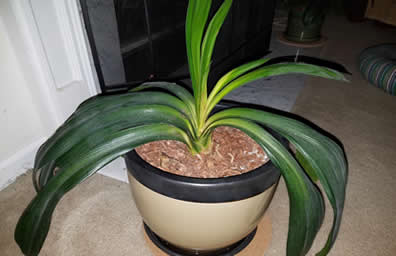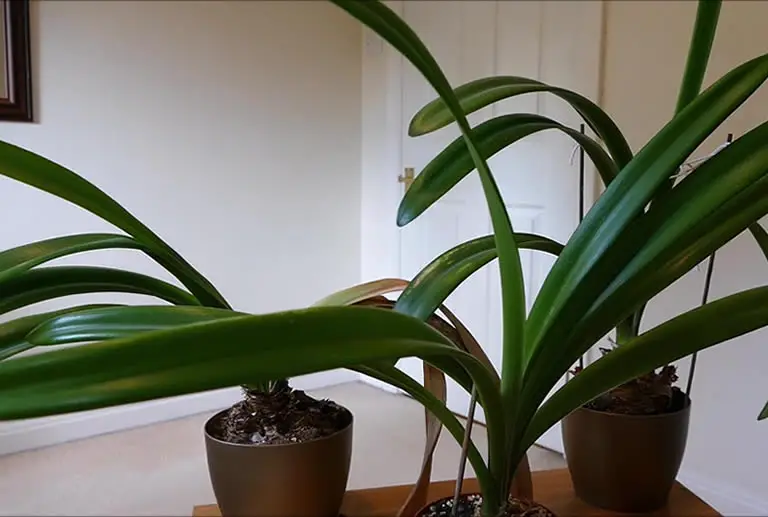Amaryllis is a popular potted plant that is common in households across the US. Its ability to bloom and rebloom without the need for constant attention makes it a great indoor houseplant. But, its large leaves that grow directly from the bulb makes them susceptible to drooping.
Table of Contents
- Why Amaryllis Leaves Droop & What You Need To Do About It
- Why The Entire Amaryllis Seems To Be Leaning Over
- How To Keep Amaryllis Upright
- The correct environment is essential for amaryllis to avoid leaves drooping
- The best soil for amaryllis to stop the plant leaning & the leaves drooping
- Give amaryllis plenty of sunlight to keep it upright
- For healthy upright leaves ensure you water amaryllis correctly
- Amaryllis will fall over & the leaves will droop if the plant sits in water-logged soil
- Stimulating the bulb before dormancy has ended can lead to leaf problems later
Why Amaryllis Leaves Droop & What You Need To Do About It
Why do amaryllis leaves fall over?
The 2 main culprits for drooping amaryllis leaves are water and sunlight.
Amaryllis are tropical plants that require frequent watering but they also require good drainage and plenty of sunlight.
Your care routine and the environment the plant is kept in need to be correct to stop amaryllis leaves from falling over.
The 2 main causes for amaryllis leaves falling over
Amaryllis can live for many years, even for decades, and is easy-to-care-for as an indoor plant.
Its low-maintenance requirements and ability to rebloom, with species of amaryllis coming in a striking range of colors, makes it the perfect easy-care indoor plant.
The Hippeastrum genus that we know commonly as amaryllis is native to the tropical and subtropical parts of the Americas growing abundantly in South America and the Caribbean as well being native to South Africa.
There are 73 genera and at 1,600 different species of this plant in the world that are grouped as being part of the Amaryllidaceae family.
Luckily, although there are many different variations of amaryllis, all species require the same care requirements.
Although the deep green leaves and aesthetics of these plants appear to be as far removed from common succulents as you can get, the cacti and hawthoria being great examples, amaryllis like aloe vera are indeed succulents.
They therefore require a somewhat different approach to their care than most other houseplants.

But, surprisingly, they also require a different care routine from most other types of household succulents.
So, what are the most common causes for drooping leaves on amaryllis?
The 2 most common causes of amaryllis leaves falling over are:
- Incorrect watering.
- Insufficient sunlight.
Let’s take a look at these causes in more detail so you can discover the simple cures.
How to identify the cause for your amaryllis leaves drooping
There can be a few different reasons for your amaryllis leaves drooping.
However, in the vast majority of cases there are two main culprits.
I will cover the less common causes or amaryllis leaves drooping later in this article but your first point of attention should be the most common causes.
What are they?
Insufficient sunlight and insufficient water will cause amaryllis leaves to droop.
Amaryllis is a tropical succulent that requires plenty of sunlight even when it is entering a stage of dormancy after blooming.
Frequent watering is also essential, but so too is good drainage as it does not respond well to sitting in waterlogged soil.
So, in order to stop amaryllis leaves from falling over you must ensure the plant has plenty of sunlight and sufficient amounts of water.
The plant also requires a pot with plenty of drainage.
Although it is possible to cultivate amaryllis in a water medium, this plant does not enjoy sitting in water.
Amaryllis plants that are cultivated in water may survive and grow but they will never truly thrive. Most water grown amaryllis are sickly plants with lack lustre blooms – at least when compared with amaryllis that are grown in the correct soil.
Why The Entire Amaryllis Seems To Be Leaning Over
Because the leaves form directly from the bulb of an amaryllis plant when they droop the entire plant leans over.
Amaryllis will lean if it is given too little water or if the soil has insufficient drainage.
A lack of sunlight will also lead to a drooping of amaryllis leaves thus causing the plant to lean.
To stop your amaryllis plant from leaning follow the advice below for stopping the leaves from drooping.
How To Keep Amaryllis Upright
So how do you stop the leaves from falling over and keep your amaryllis plant upright?
To keep amaryllis leaves from drooping and ensure your plant stays upright you must get its care routine correct and ensure it is kept in the correct environment.
The plant needs plenty of sunlight and frequent watering.
The pot that houses amaryllis must have good drainage and the correct soil.
As I previously mentioned, although there are 1600 different varieties of amaryllis they all have the same care requirements so you do not need to know the exact species to solve your plant’s problem.
Below is an overview of the correct care needs of an amaryllis plant to ensure it remains healthy, upright and continues to bloom for decades.
The correct care of amaryllis needed to ensure the leaves, and thus the plant, stay upright requires you to ensure the following criteria are met:
- The correct soil must be used.
- The plant must get plenty of sunlight.
- The plant needs to be frequently watered.
- The pot the plant is grown must have adequate drainage.
- The bulb must be allowed to go into dormancy.
Let’s take a quick look at each of the above care requirements in closer detail.
The correct environment is essential for amaryllis to avoid leaves drooping
Amaryllis need to be kept in the correct environment to ensure they grow healthily and produce colorful blooms and reblooms.
Drooping leaves are an indication that something is wrong with the care routine of this succulent and the first thing to look at its the plant’s environment.
This involves several factors from the pot the plant is growing in to the soil and the amount of water and sunlight the plant is getting.
As amaryllis is most commonly kept in the US as a houseplant, though it is occasionally grown outdoors in certain zones (8 through 10), due to its tropical nature and specific water needs it is essential to get its environment correct.

Amaryllis will root from bulb in warmer temperatures between 70 – 75 degrees Fahrenheit and if possible this is the temperature you should aim for when first cultivating the plant.
However, for a adult plant that has already formed stalks the best temperature is around 65 degrees fahrenheit.
The plant will live happily at this temperature for the rest of its life.
Amaryllis also require a pot that is large enough to house an adult plant.
As you will see soon, amaryllis also require plenty of sunlight so ensure you do not place your potted plant in a dark or gloomy area of your house where the plant will struggle to get enough UV light.
The best soil for amaryllis to stop the plant leaning & the leaves drooping
Amaryllis can be cultivated in water but they will only really thrive when they are planted in the correct soil.
Amaryllis grow best when they are crowded, so even when you are growing from bulb they don’t need too much soil.
A great soil to grow amaryllis in is an organic rich potting mix.
Miracle-gro potting mix, or similar soil, offers amaryllis everything it needs to get started and to thrive through its growth cycles.
Give amaryllis plenty of sunlight to keep it upright
Amaryllis responds poorly to low light. A lack of sufficient sunlight is one of the most common reasons for drooping leaves on an amaryllis plant.
Arguably, it is the most common cause for a leaning amaryllis.
So, to avoid drooping leaves you should ensure your plant is kept somewhere in your home that gets plenty of sunlight.
If you find that the leaves on your amaryllis are drooping despite it getting plenty of water, in a well drained pot, then the most likely cause is lack of sunlight.
Move your amaryllis to a location that gets more sunlight ensuring you continue its watering routine.
For healthy upright leaves ensure you water amaryllis correctly
Although most succulents do not react well to frequent watering, amaryllis are one of the small few that actually require frequent watering.
Having said that, when first cultivating amaryllis from bulb water it sparingly until you see about 2″ of stalk growth. Then water regularly.
How much water do you need?
You should allow the top layer of the soil to dry out before watering amaryllis. This does not mean you should wait until the soil is completely dry.
Only the top layer should be allowed to dry out. Use your finger to test this.

Place your finger about 1 – 2 centimeters into the top layer of the soil and if it comes out dry then your plant needs watered.
If you remove your finger and it has soil on it then you don’t need to water it.
Be aware that 2 cm is not very deep and is roughly the length of the first phalange of your finger – from tip of the finger to the first bend in it.
Amaryllis will fall over & the leaves will droop if the plant sits in water-logged soil
Although amaryllis require frequent watering they hate sitting in water.
Yes, I know that they can be grown in water but water-grown amaryllis are a poor substitute for soil-grown ones.
They lack the colorful bloom and are unlikely to live as long.
So although amaryllis need frequent watering be aware that frequent watering doesn’t mean saturating the soil.
If the soil, the amaryllis is growing in, is water-logged the plant will develop some serious problems.
On the surface it may appear that only the leaves are dropping but below the surface the roots could be getting attacked by fungal infections and/or rotting.
This is why is is very important to ensure the pot you grow your amaryllis in has good drainage. Amaryllis roots like damp soil but they do not like waterlogged soil.
Stimulating the bulb before dormancy has ended can lead to leaf problems later
After amaryllis have bloomed the bulb will want to go into a dormant phase and should be allowed to do so. Amaryllis bulbs require between 2 – 3 months of dormancy to rest.
Amaryllis bulbs do not require dark conditions during dormancy but they do need you to avoid over stimulating them or trying to force them to rebloom when they should be resting.
Stimulating the bulb when it should be resting is a sure fire way to stunt the growth of the plant and lead to problems next blooming phase.
Anb overworked amaryllis bulb will lead to limp pale green leaves and a lack of blooms or poor blooms.
How do you avoid over-stimulating amaryllis when it is entering dormancy?
It is very easy to avoid over-stimulating an amaryllis bulb that is entering dormancy – don’t fertilize it! Stopping an amaryllis bulb from enter dormancy is almost always caused by fertilizing the plant at the wrong time.
Although fertilizing amaryllis is a good idea you should never do it after the plant has bloomed as you should allow it to go dormant at this stage.
At this stage, even though the plant is entering dormancy, you should make sure it is getting plenty of sunlight.
Is is at this stage that the bulb will gather and store as much resources as it can before it sleeps.

